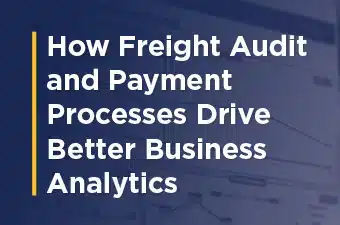In 2025 shippers have enjoyed some breathing room. Spot and contract rates are soft compared to the volatility of 2022 and 2023. On the surface, freight costs appear manageable.
Is this an illusion?
Lower commercial shipping rates often lull companies into overlooking invoice reviews and freight audit services. Meanwhile billing errors, accessorial disputes and inconsistent payment processes continue to erode profit.
The Cass Freight Index shows shipments declining year-over-year while expenditures remain elevated. This persistent gap between freight volumes and overall spend highlights the importance of continuous auditing and payment validation. In this environment, robust freight audit and payment solutions remain critical to protect margins and ensure true supply chain visibility.
The Scale of the Opportunity in Freight Audits
Freight invoices are complex. Linehaul charges, fuel surcharges, accessorials and freight classifications all create opportunities for mistakes.
A typical freight bill audit finds that between 3 and 6 percent of invoices contain errors. Most of these errors come from accessorial charges or misapplied discounts. For most shippers, this translates into 1 to 5 percent of total freight spend recoverable through accurate audit and resolution.
Even small percentages add up to meaningful savings when applied across a large shipping network. The right freight audit service not only recovers dollars but also provides the foundation for more effective freight spend analysis and long-term cost control.
Resolution vs. Flagging: Why the Difference Matters
Some providers stop at identifying discrepancies, leaving shippers to handle disputes and chase credits. This “flag only” model increases administrative workload and creates the risk of missed recoveries.
A resolution-first freight audit goes further. It corrects issues, secures credits and addresses root causes to prevent future errors. This approach reduces repeat problems, preserves cash flow and ensures that savings are permanent rather than temporary.
The Data Dividend: From Freight Analysis to Optimization
Corrected invoices do more than protect today’s dollars. Each one becomes a reliable data point that strengthens the accuracy of a shipper’s entire spend profile. Over time this creates a clean, validated dataset that enables better decision making.
With trustworthy information in hand, shippers can analyze carrier performance, track true accessorial costs and forecast more accurately against market indices. This insight supports smarter mode decisions when balancing TL and LTL freight, sharper transport optimization strategies and a clearer understanding of total landed cost.
A recent Deloitte analysis found that companies can save 3–6 percent simply by improving visibility into freight spend. That level of savings dwarfs what most shippers expect to recover from error correction alone, showing how clean audit data fuels broader supply chain strategy.
A freight audit should not stand alone. When integrated with advanced freight software such as transportation management systems (TMS) and business intelligence platforms that deliver key supply chain analytics, the impact extends well beyond error recovery. Shippers can run what-if scenarios, test future strategies and plan more confidently in an uncertain market.
Beyond Dollars: Ripple Effects Across the Supply Chain
The advantages of a resolution-first audit extend across the logistics ecosystem. For shippers, fewer billing disputes ease the workload on internal teams, allowing staff to shift focus from clerical tasks to higher-value initiatives like procurement strategy and network design. Industry research shows that as much as 20% of accounts payable staff time is spent solely on invoice disputes, so reducing these issues creates immediate productivity gains.
Customers benefit as well. Accurate invoices and predictable costs mean service commitments are easier to meet, and you avoid disruptions caused by billing disputes. That reliability translates into stronger relationships and repeat business.
Carriers also see gains. When you resolve disputes quickly and consistently, trust improves. Carriers spend less time revisiting old invoices and more time collaborating on rates, capacity and service improvements. This creates healthier long-term partnerships and a stronger position in future negotiations.
In short, a freight audit program built on resolution does more than clean up invoices. It creates stability, predictability and confidence for everyone in the supply chain.
From Modest Savings to Strategic Advantage
Soft rates may feel like relief, but they can hide the impact of inaccurate invoices. Left unchecked, these errors quietly erode profit and weaken visibility into true costs. A freight audit that focuses on resolution can protect 1 to 5 percent of freight spend that you might otherwise lose.
The benefits do not stop there. Clean, reliable data improves forecasting, supports smarter mode choices and drives optimization across the transportation network. It also reduces the administrative burden of disputes, strengthens customer service commitments and enhances carrier relationships.
A freight audit should not stand alone. It is most powerful when embedded into a managed transportation solution supported by advanced freight software and business intelligence platforms. At Transportation Insight, we integrate freight audit with optimization strategies and supply chain analytics that deliver actionable intelligence. This combination transforms auditing from a tactical safeguard into a strategic advantage.
By moving beyond flagging to resolution, shippers can safeguard today’s margins and build a smarter, more resilient transportation strategy for tomorrow. With Transportation Insight as a partner, you will have our proven expertise, advanced technology and unwavering focus on protecting your profit guiding your strategy.
What if 5% of your freight spend is leaking away? Connect with us to get an evaluation started.




